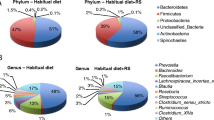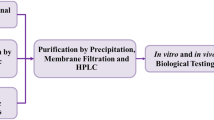Abstract
Okara is a by-product of soymilk manufacturing and a rich source of protein and dietary fiber. This study investigates whether dietary soymilk-okara powder intake in the long term affects the body composition and gut microbiota flora in healthy Japanese adults. In total, 46 subjects (43 women) were enrolled. All subjects ingested 15 g of soymilk-okara powder every day for 12 weeks. Subjects’ body composition was assessed over four weeks. At baseline and after intervention for 12 weeks, fecal short-chain fatty acid concentrations and microbiota percentages were measured. The body muscle weight significantly increased, and the percentage of body fat significantly decreased at 4, 8, and 12 weeks after the intervention. The increase in body muscle after 12 weeks was 0.6 kg (interquartile range:–0.03 to 1.0). The decrease in body fat was –0.9% (interquartile range: -1.6 to -0.2). There was a significant negative correlation between the changes in body fat and body muscle. For the fecal percentages of Coriobacteriaceae, Lactobacillales, Bacteroides, Clostridium cluster IV, and Clostridium cluster XI, there were significant differences between the baseline and 12 weeks after the intervention. Furthermore, there were significant negative correlations between the changes in body fat percentage and fecal acetic acid and propionic acid levels. Therefore, a dietary intake of 15 g of soymilk-okara powder for 12 weeks induced a decrease in body fat, an increase in body muscle, and a change in fecal microbiota flora. Soymilk-okara powder is effective in improving body composition and changing the intestinal microbiota flora in healthy Japanese adults.


Similar content being viewed by others
Data Availability
Not applicable.
Abbreviations
- BG :
-
Blood glucose
- BMI :
-
Body mass index
- Chol :
-
Cholesterol
- HDL :
-
High-density lipoprotein
- LDL :
-
Low-density lipoprotein
- SCFA :
-
Short-chain fatty acid
- SD :
-
Standard deviation
References
Ono T, Shimoyama M, Muramoto K (2012) Function and science of soybean. Asakurasyoten, Tokyo, Japan. [Japanese]
Ministry of Education, Culture, Sports, Science and Technology Japan Standard tables of food composition in Japan 2020. https://www.mext.go.jp/a_menu/syokuhinseibun/mext_01110.html Accessed 29 Dec 2021. [Japanese]
Malik VS, Li Y, Tobias DK, Pan A, Hu FB (2016) Dietary protein intake and risk of type 2 diabetes in US men and women. Am J Epidemiol 183(8):715–728. https://doi.org/10.1093/aje/kwv268
Harland JI, Haffner TA (2008) Systematic review, meta-analysis and regression of randomised controlled trials reporting an association between an intake of circa 25 g soya protein per day and blood cholesterol. Atherosclerosis 200(1):13–27. https://doi.org/10.1016/j.atherosclerosis.2008.04.006
Hirotsuka M (2018) Possibility verification of soybean β-conglycinin as ‘food with function claims.’ Oyo Yakuri Pamacometrics 94(1–2):5–13
Mu Y, Kou T, Wei B, Lu X, Liu J, Tian H, Zhang W, Liu B, Li H, Cui W, Wang Q (2019) Soy products ameliorate obesity-related anthropometric indicators in overweight or obese Asian and non-menopausal women: a meta-analysis of randomized controlled trials. Nutrients 11(11):2790. https://doi.org/10.3390/nu11112790
Funatsu Y, Nishimura Y, Ishioroshi M, Uebaba K, Nishio Y, Terashima T, Mafune N (2008) Hypoglycemic effect pf tofu refuse-enriched cake on blood glucose level in healthy subjects and its sensory attributes. Nippon Shokuhin Kagaku Kogaku Kaishi 55(8):367–372. [Japanese]. https://doi.org/10.3136/nskkk.55.367
Nguyen LT, Nguyen TH, Nguyen LT, Kamoshita S, Tran TP, Le HT, Shimura F, Yamamoto S (2019) Okara improved blood glucose level in Vietnamese with type 2 diabetes mellitus. J Nutr Sci Vitaminol (Tokyo) 65(1):60–65. https://doi.org/10.3177/jnsv.65.60
Corpuz HM, Arimura M, Chawalitpong S, Miyazaki K, Sawaguchi M, Nakamura S, Katayama S (2019) Oral administration of okara soybean by-product attenuates cognitive impairment in a mouse model of accelerated aging. Nutrients 11(12):2939. https://doi.org/10.3390/nu11122939
Maeta A, Katsukawa M, Inomoto Y, Hayase Y, Takahashi K (2020) Intake of okara soup for 2 weeks for breakfast improved defecation habits in young Japanese women with self-reported constipation: a randomized, double-blind, placebo-controlled, intervention study. J Food Sci 85(10):3570–3576. https://doi.org/10.1111/1750-3841.15392
Zhao Y, Liu J, Hao W, Zhu H, Liang N, He Z, Ma KY, Chen ZY (2017) Structure-specific effects of short-chain fatty acids on plasma cholesterol concentration in male Syrian hamsters. J Agric Food Chem 65(50):10984–10992. https://doi.org/10.1021/acs.jafc.7b04666
Kondo T, Kishi M, Fushimi T, Ugajin S, Kaga T (2009) Vinegar intake reduces body weight, body fat mass, and serum triglyceride levels in obese Japanese subjects. Biosci Biotechnol Biochem 73(8):1837–1843. https://doi.org/10.1271/bbb.90231
Kohno M, Hirotsuka M, Kito M, Matsuzawa Y (2006) Decreases in serum triacylglycerol and visceral fat mediated by dietary soybean beta-conglycinin. J Atheroscler Thromb 13(5):247–255. https://doi.org/10.5551/jat.13.247
Tagawa R, Watanabe D, Ito K, Ueda K, Nakayama K, Sanbongi C, Miyachi M (2020) Dose-response relationship between protein intake and muscle mass increase: a systematic review and meta-analysis of randomized controlled trials. Nutr Rev 79(1):66–75. https://doi.org/10.1093/nutrit/nuaa104
Ley RE, Turnbaugh PJ, Klein S, Gordon JI (2006) Microbial ecology: human gut microbes associated with obesity. Nature 444(7122):1022–1023. https://doi.org/10.1038/4441022a
Ozato N, Saito S, Yamaguchi T, Katashima M, Tokuda I, Sawada K, Katsuragi Y, Kakuta M, Imoto S, Ihara K, Nakaji S (2019) Blautia genus associated with visceral fat accumulation in adults 20–76 years of age. NPJ Biofilms Microbiomes 5(1):28. https://doi.org/10.1038/s41522-019-0101-x
Yoshimoto S, Loo TM, Atarashi K, Kanda H, Sato S, Oyadomari S, Iwakura Y, Oshima K, Morita H, Hattori M, Honda K, Ishikawa Y, Hara E, Ohtani N (2013) Obesity-induced gut microbial metabolite promotes liver cancer through senescence secretome. Nature 499(7456):97–101. https://doi.org/10.1038/nature12347
Sasaki D, Sasaki K, Ikuta N, Yasuda T, Fukuda I, Kondo A, Osawa R (2018) Low amounts of dietary fibre increase in vitro production of short-chain fatty acids without changing human colonic microbiota structure. Sci Rep 8(1):435. https://doi.org/10.1038/s41598-017-18877-8
Hattori M, Kondo T, Kishi M, Yamagami K (2010) A single oral administration of acetic acid increased energy expenditure in C57BL/6J mice. Biosci Biotechnol Biochem 74(10):2158–2159. https://doi.org/10.1271/bbb.100486
Kimura I, Inoue D, Maeda T, Hara T, Ichimura A, Miyauchi S, Kobayashi M, Hirasawa A, Tsujimoto G (2011) Short-chain fatty acids and ketones directly regulate sympathetic nervous system via G protein-coupled receptor 41 (GPR41). Proc Natl Acad Sci USA 108(19):8030–8035. https://doi.org/10.1073/pnas.1016088108
Kimura I, Ozawa K, Inoue D, Imamura T, Kimura K, Maeda T, Terasawa K, Kashihara D, Hirano K, Tani T, Takahashi T, Miyauchi S, Shioi G, Inoue H, Tsujimoto G (2013) The gut microbiota suppresses insulin-mediated fat accumulation via the short-chain fatty acid receptor GPR43. Nat Commun 4:1829. https://doi.org/10.1038/ncomms2852
Acknowledgements
We extend our sincerest gratitude to the Mukogawa Women University employees who participated in this study. Additionally, we are grateful to Izumoto Kozue, who entered the questionnaire data. Moreover, we would like to thank Editage for English language editing.
Funding
K.T. and A.M have received research grant from the Kikkoman Food Products Company.
Author information
Authors and Affiliations
Contributions
Conceptualization, A.M., M.K., Y.H., and K.T.; methodology, A.M., M.K., Y.H., and K.T.; validation, A.M. and K.T.; formal analysis, A.M. and M.K.; investigation, A.M. and K.T.; resources, Y.H. and K.T.; data curation, A.M. and M.K.; writing—original draft preparation, A.M.; writing—review and editing, M.K., Y.H., and K.T.; visualization, A.M.; supervision, Y.H. and K.T.; project administration, A.M.; funding acquisition, Y.H. and K.T. All of the authors have read and agreed to the published version of the manuscript.
Corresponding author
Ethics declarations
Author Disclosure
M.K. and Y.H. are employees of Kikkoman Food Products Company. This work was supported by the Kikkoman Food Products Company.
Ethics Approval
The study protocol was approved by the Ethics Committee of Mukogawa Women’s University (Permit Number: 20–89).
Consent to Participate
The purpose and protocol of this study were explained to all participants, and written informed consent was obtained.
Consent for Publication
All authors and participants consent to publish this manuscript.
Competing Interests
K.T. and A.M have received research grant from the Kikkoman Food Products Company. This work was supported by the research grant from Kikkoman Food Products Company.
Additional information
Publisher's Note
Springer Nature remains neutral with regard to jurisdictional claims in published maps and institutional affiliations.
Supplementary Information
Below is the link to the electronic supplementary material.
Rights and permissions
Springer Nature or its licensor (e.g. a society or other partner) holds exclusive rights to this article under a publishing agreement with the author(s) or other rightsholder(s); author self-archiving of the accepted manuscript version of this article is solely governed by the terms of such publishing agreement and applicable law.
About this article
Cite this article
Maeta, A., Katsukawa, M., Hayase, Y. et al. Intake of Soymilk-Okara Powder for 12 Weeks Decreases Body Fat and Increases Body Muscle in Japanese Adults: a Single-Arm Intervention Study. Plant Foods Hum Nutr 78, 173–178 (2023). https://doi.org/10.1007/s11130-022-01030-w
Accepted:
Published:
Issue Date:
DOI: https://doi.org/10.1007/s11130-022-01030-w




